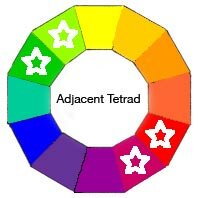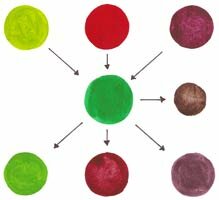Adjacent Tetrad Color Schemes

An Adjacent Tetrad color scheme works with four colors. It’s basically a very narrow rectangle on the Color Wheel.
To pick your palette, select your dominant Hue or Mother Color, which is Green in our example.
Next select the color right beside it. You could go either clockwise or counterclockwise. In our example we go clockwise which gives us Yellow/Green. Now just go straight across the Color Wheel and form a rectangle by choosing the opposite two colors.
Notice that when you select the pairs of colors right across from each other to form an imaginary rectangle, you’ve automatically selected two pairs of Complementary Colors. There are also two other Tetrad configurations which combine two pairs of Complementary Colors. These combinations can be a little tricky if you mix colors without thinking.
The Adjacent Tetrad is the most challenging because there are no spaces between each two pairs of analogous of colors.
An Adjacent Tetrad Color Scheme contains:
- one Primary Color
- one Secondary Color
- two Tertiary Colors
You can see in the example below how they interact with each other. Use this Color Scheme when you want drama and strong temperature contrast.
Example of an Adjacent Tetrad Color Scheme

Here Green as our main Mother Color and shown in the center. Yellow/Green is the color next to it, going clockwise on the Color Wheel. Directly across are Red and Red/Violet shown in the top row.
- Yellow/Green + a tiny bit of Green = Bright Green
- Red + a tiny bit of Green = Muted Red / Burgundy
- Red/Violet + a tiny bit of Green = Muted Violet
- All four colors mixed = Neutral Brown or Grey.
Green is the direct Complementary of Red. And Red/Violet also contains Red, so it also gets toned down by the Green in similar ways. Yellow/Green is adjacent to Green so it becomes intensified by adding the Green Mother Color.
Remember to proceed with caution when mixing these double complements because Complementary Hues cancel each other out. Be careful to add only the tiniest amount of the Mother Color at one time. These paint colors will get muddy brown very quickly with aggressive mixing.
For a wider range of paint colors add varying amounts of White, Black or Gray to tint, shade or tone down the colors even more.
Of course you have the option of choosing any of the other three colors as your Mother Color. This would give you entirely different paint mixtures but still pose the same challenges.
Painting Tips for an Adjacent Tetrad Color Scheme
- Adjacent Tetrad color schemes work best if you make one of the adjacent pairs more dominant by using them and their variations in about 75% of the space.
- Avoid adding too much of each Complementary color or your paint mixtures will be dull.
- Use different brightness intensities of your mixtures with varying ratios of the colors.
- Create a wide range of neutrals with the complementary combinations. Change the way they look by adding white to lighten, black to darken and grey to tone down.
- For contrasting focal points and accents, choose variations of the non-dominant colorswhich will most likely be the Complements.
- Avoid using the Mother Color or any other color full-strength. Always add a tiny bit of another hue to make it interesting and less garish.
Check out these Color Schemes
Complementary
Near Complementary
Triad
Complementary Triad
Modified Triad

